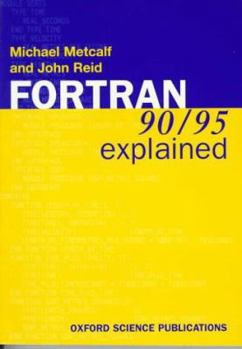FORTRAN 90/95 Explained
The success of Fortran as the predominant programming language in the field of scientific and numerical computing is due, in part, to its steady evolution. Following the publication of standards in 1966 and 1978, the committee responsible for their development, X3J3, worked in conjunction with an ISO committee to develop a standard suitable for use in the 1990's and beyond. This standard, ISO Fortran 90, contained new features for large-scale computing nd data abstraction, but still retained all the old familiar features. Fortran 90/95 Explained is a thorough examination of Fortran in 1995. It represents a complete revision of the original 1990 text Fortran 90 Explained, in particular a more detailed explanation of many features, more examples, and new appendices. One completely new chapter discusses Fortran 95, a revision of the ISO Fortran 90 standard based on the interpretations that have been requested following its implementation and use. In addition, new features to keep ISO Fortran aligned with High Performance Fortran have been added, along with a number of minor improvements. All of these are fully described for programmers wanting to update their skills.
Format:Paperback
Language:English
ISBN:0198518889
ISBN13:9780198518884
Release Date:July 1996
Publisher:Oxford University Press, USA
Length:360 Pages
Weight:1.40 lbs.
Dimensions:0.9" x 6.6" x 9.4"
Customer Reviews
4 ratings
Concentrated Acid for FORTRAN 95
Published by Thriftbooks.com User , 22 years ago
For the experienced FORTRAN 77 programmer, this is the best book you can own for learning FORTRAN 90/95. Don't be fooled by its unimpressive size, the content is what's important and the only metaphor I can find is this: the contents of this little jewel are like concentrated acid. I'm not at all surprised the authors of Numerical Recipes in FORTRAN 95 site this book as their favorite reference. This book is not for the faint at heart, but then, what successful programmer is? This rare jewel combined with Adams, Brainard, Martin, Smith, and Wagener's "FORTRAN 95 Handbook" is all the aspiring FOTRAN 90/95 programmer needs.One example of the many gold nuggets I found in this title that I could find mentioned almost nowhere else: Instead of declaring a function as EXTERNAL so that it may be used as an actual argument in a procedure reference, Metcalf and Reid recommend using an interface block in the scope of the procedure reference using the actual function name, and a similar interface block in the referenced procedure (using the dummy argument procedure name), thereby allowing the compiler to envoke all the checking associated with explicit interfaces. Using the EXTERNAL attribute for this scenario does not allow that depth of checking, and, indeed, Chapman makes it seem as if the EXTERNAL statement is required to pass a function name as an actual argument. Adam's et al write that the use of interface blocks makes this use of EXTERNAL effectively obsolescent (p 473).I did have one problem with my edition of "FORTRAN 90/95 Explained", the index was bound incorrectly (the pages were out of sequence).
Fortran 90/95 Explained
Published by Thriftbooks.com User , 25 years ago
Fortran 90/95 explained by Metcalf and Reid is a reference work that covers systematically all the fundamental concepts in the Fortran 90 and 95 programming language standard. The text is concise, yet it is sprinkled with examples. I consult the book often and usually find quickly what I am looking for.
Essential reference book
Published by Thriftbooks.com User , 25 years ago
There are two types of essential books to be on your bookshelves. Books to learn from and books to reference.This book is the essential reference. Once you learn Fortran, this is the book to turn to when you need to know the details of the language.I find myself using this book over and over again for my research project. It's short, concise, absolutely accurate and complete, making it the perfect book to have right next to your keyboard.In response to the 1 star review, this is _not_ the book to learn the language from if you know nothing about Fortran, but it would be a serious mistake not to stock your bookshelf with this gem of a book.
The first F90 book I reach for
Published by Thriftbooks.com User , 25 years ago
In my opinion this book gives a thorough, yet concise account of the Fortran 90 programming language and its more recent Fortran 95 revision. Its virtue lies in its unambiguous definition of terms, programming constructs, function definitions etc. It is ideal for the experienced programmer who wants to know how to code a specific task in Fortran 90. It is most definitely not suitable, nor aimed at either the novice programmer or the programmer of the Fortran 66 era; both of whom need a slower, more example and algorithm driven, introduction to the Fortran of the 90's. I have successfully used this book for teaching, but only to experienced Fortran 77 programmers eager to learn about the new language, and with the aid of highly structured lectures and supervised computer tutorial sessions. I would not recommend it for student self study.As an experienced programmer, what I most like about this book is that I can look up a term in the index, be referred to a small number of entries in the text, and rest assured that in those few pages I have all the information I require on that topic. Other Fortran books I have read frequently do not document, or pay scant regard to, important features of the language such as optional arguments to I/O statements or generic function disambiguation.If I were only allowed to keep just one Fortran 90 text book this would be the one.






